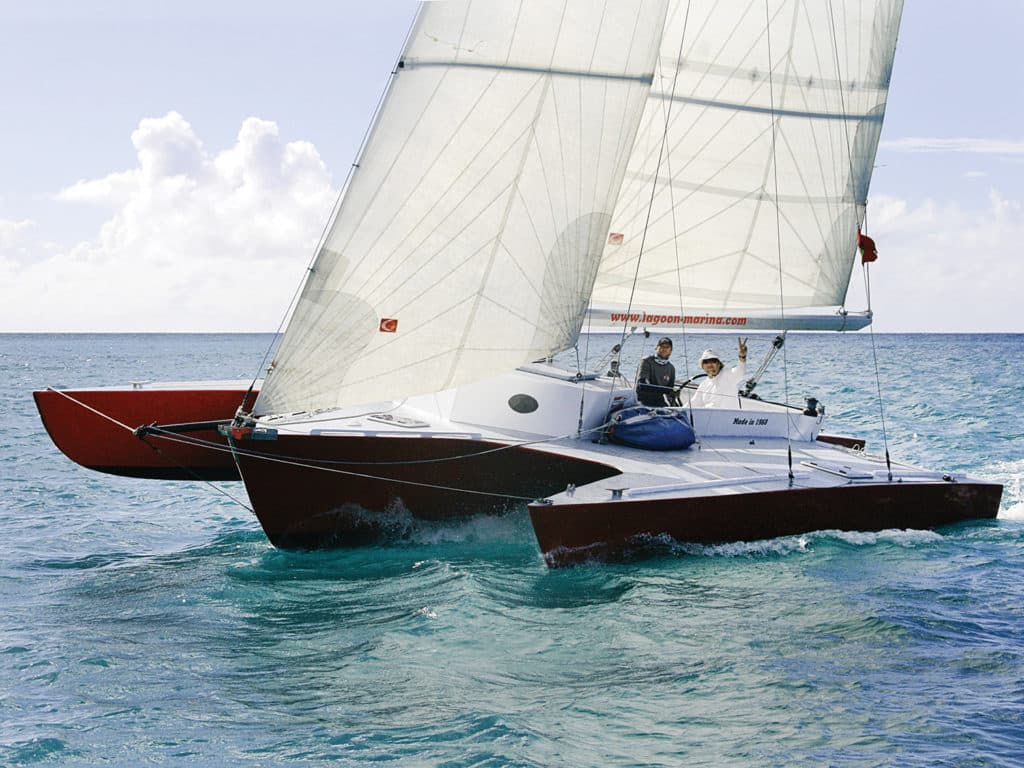
If you blinked hard, and quickly, a fairly concise history of multihull sailing on the blue waters of the Caribbean was right there in front of you, for all of the sailing world to see. Glancing to port, as graceful as a soaring bird in flight, was the bright-red trimaran Tryst, having just turned a nice round 50, but still pretty as the proverbial picture. Her legendary designer, Dick Newick, had his very own style every bit as distinctive as anyone named Herreshoff, and Tryst‘s fluid lines have aged extremely well. If anything, despite the years and the savage hurricanes that tried so hard to destroy her, she’s lovelier than ever.
But what was that, to starboard, screaming through the slight chop on a tight reach, faster than a speedboat with an open throttle? Oh, yes: Fujin. Designed by an America’s Cup hotshot near Seattle but built in the relatively nearby Virgin Island of St. Croix, with her striking, aggressive bows, Fujin had the no-nonsense mien of a racecourse badass. It was hard to believe that just a short year ago she was upside down off the island of Saba, her crew treading water, having capsized in an ocean race. Now, she looked like a world beater.
Tryst and Fujin. Trimaran vs. catamaran. Wood vs. carbon. Old vs. new. Different. But the same. Multihulls. In a watery class of sailboats all by themselves, deserving of a showcase that highlights everything that stands them apart and brings them together.
Which leads us to the event that did just that—last spring’s first running of the Caribbean Multihull Challenge, in the sparkling seas off the isle of St. Maarten.
Paying Homage
It was 1979 when a young sailor named Robbie Ferron washed up on the shores of St. Maarten with a keen eye for everything around him. And one of the very first things he noticed was a driven designer and builder named Peter Spronk, carving his own niche by knocking out beautiful, singular cats right on the beach.
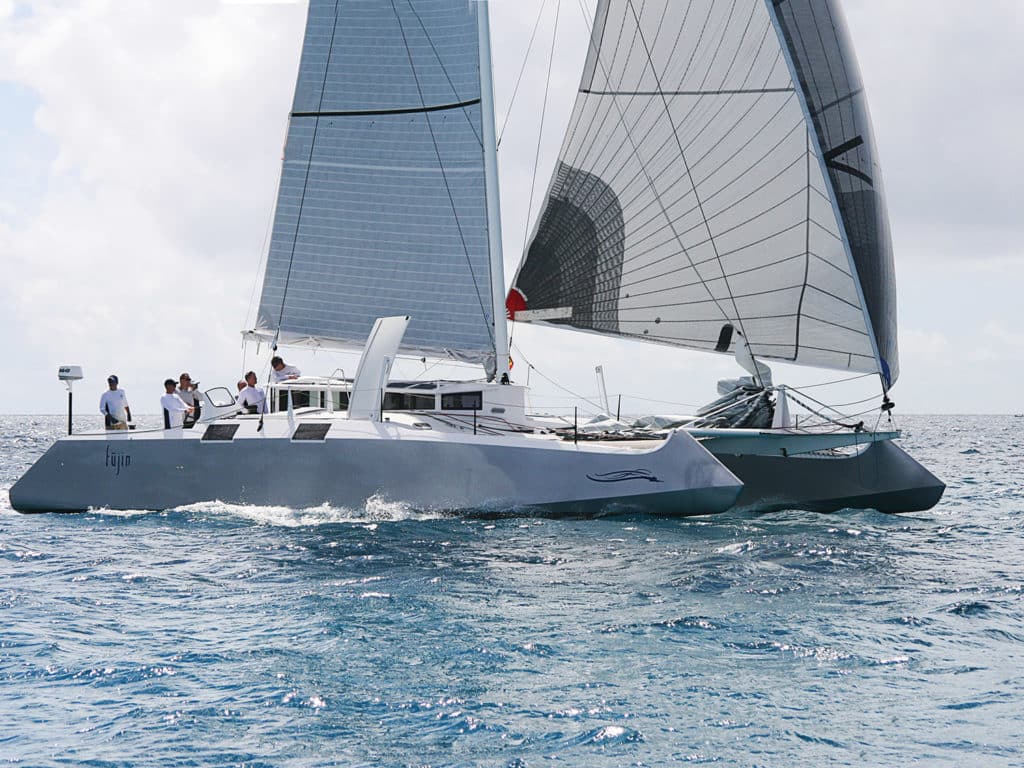
“He was a stubborn Dutchman,” Robbie said. “He was grandly stubborn. If you wanted a Spronk boat that didn’t match his concept, you were out of luck. But that made others become even more enthused about getting a boat from him. His boats were amazing, they were about simplicity and manageability. They were great sailing boats, and they did a lot of things well. They’re still very good and usable. Nothing straddles the decades like Spronks.”
Spronk was a visionary and a pioneer, but he was also on the crest of a wave that has risen steadily in the intervening decades. While cats were at one time a curiosity, a sideshow, they’ve become ubiquitous in charter fleets, offshore races and distant anchorages all around the world. “When you look at new-boat arrivals in the Caribbean now, they’re dominating,” said Robbie, who, as the founder of the Caribbean chandlery Budget Marine, knows whereof he speaks. “The percentage of multihulls is constantly increasing.”
With a couple of like-minded localsailors—Petro Jonkers, who sails a Leopard 47 cat, and Stephen Burton, a cruiser who skippers a Swan 411 and enjoys nothing more than promoting his pastime—Robbie decided to do something to acknowledge that fact, to pay homage to Spronk, St. Maarten, multihulls, and the happy maniacs who love and sail them. An annual regatta celebrating all things multihull seemed appropriate and the busy, forward-thinking St. Maarten Yacht Club, the host for nearly four decades of the wildly popular St. Maarten Heineken Regatta (and the club where Robbie, Petro and Steve were all members), proved to be a willing accomplice.
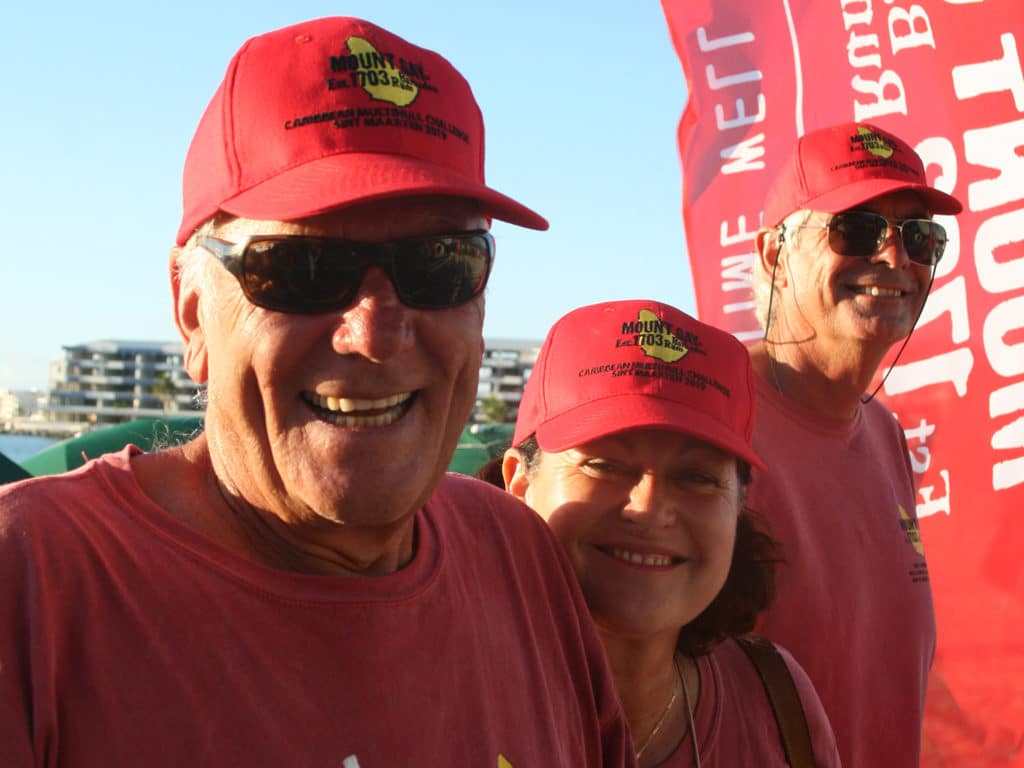
Fifteen boats signed up for the inaugural edition, which took place early last February with three days of racing and shore-side celebrations. And an eclectic fleet it was.
In addition to Tryst, there was a trio of trimarans: Liquid Spirit, a Neel 45 cruising tri built in France with a Dutch crew at the outset of an extended cruise; Ineffable, a rare Melvin & Morelli-designed tri skippered by Stephen Glyn Bourne with a homeport of Hong Kong (which would ultimately be honored as the yacht that traveled the farthest to participate); and Le Tri, like Tryst a St. Maarten boat with a talented island crew.
Fujin was the scratch boat among the racing cats, but it had plenty of heady company, especially the HH66 R-Six—built in China and sailed by a wild Polish crew—and several one-off local cats, including the 60-footer Arawak, the M&M-designed 50-footer Shooting Star, the doublehanded 28-footer Enola and Guimamalou, a 40-footer.
And of course, no multihull event would be replete without a good showing of production cats, the fastest-growing segment in the contemporary sailboat market. The South African builder Robertson & Caine was well-represented by a pair of St. Maarten-based Leopards, Petro’s Seaduction and a 45-footer, Spellbound. Finally, and fittingly, there were several cats with a French pedigree: Hey Jude (Lagoon 410), Primula (Fountaine Pajot Belize 43) and Think Good Thoughts (Outremer 49) for the Caribbean Multihull Challenge.
With regards to the field, as far as a cross section of the multihull world was concerned, it was a fine one.
God of Wind
One boat, however, stood out among all the others, in both appearance and performance. That yacht was the cutting-edge 53-footer called Fujin.
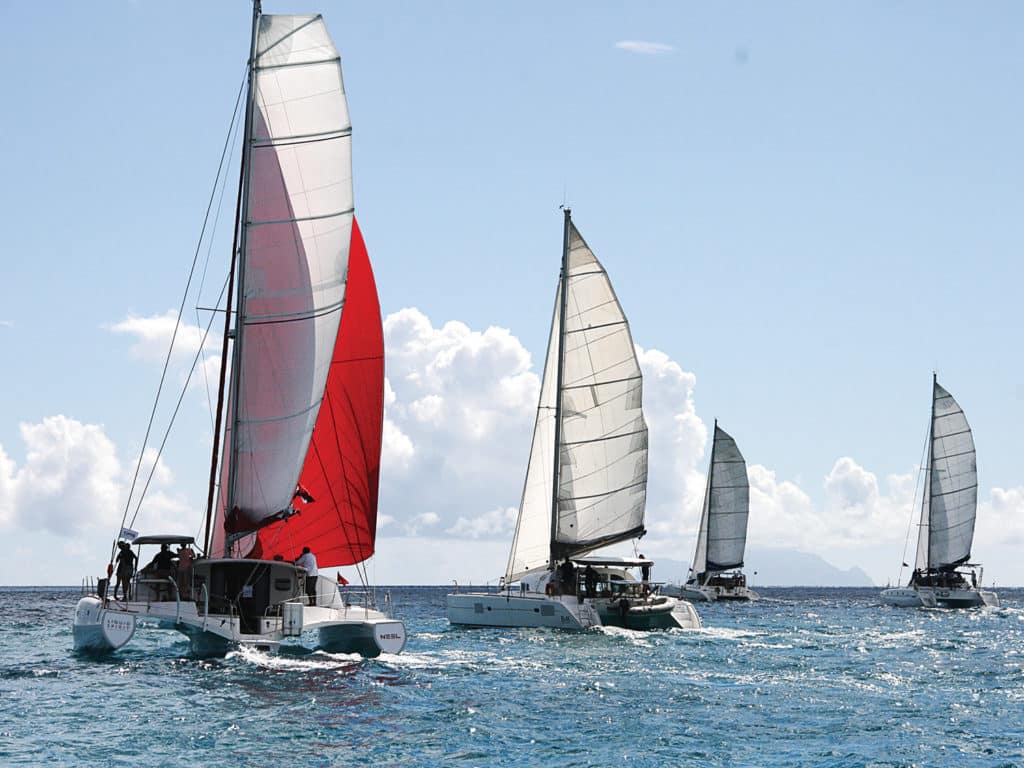
After years working for Microsoft, Greg Slyngstad settled into a comfortable retirement as a self-professed “sailing bum.” He competed in several St. Maarten Heineken Regattas aboard a series of monohulls before commissioning Pacific Northwest naval architect Paul Bieker—who at the time was working with the Team Oracle USA America’s Cup campaign—to design a quick, light cat. And thus, Fujin was born. During his Microsoft days, Slyngstad spent some time in Japan and became immersed in the country’s culture, and named his boat after the Japanese god of wind.
“I was looking for a name that was different, and I liked the sound of Fujin,” he said. “It’s a very fast boat. We’ve topped off at over 32 knots. It doesn’t have a very big rig compared to most of the big multihulls we race against, so in light air we struggle a bit. But once the wind gets to about 15 knots Fujin is one of the fastest cats out there. It’s been a lot of fun.”
Weighing in at around 7 tons (less than half the weight of a Gunboat 55), the all-carbon cat was built in St. Croix by Gold Coast Yachts. While extremely light, she still sports a full cruising interior and is a true dual-purpose racer/cruiser. She’s also a handsome boat with a unique profile that Slyngstad describes as “a unique Polynesian look.”
Designer Bieker had concrete reasons, beyond appearances, for creating those striking bows. Slyngstad said that when Fujin is fully powered up, there’s a tendency for the transom to lift, so Bieker added volume and floatation forward to keep the bows from punching into waves and to prevent any chance of pitchpoling.
Yacht designer Peter Spronk was a visionary and pioneer, but he was also on the crest of a wave that has risen steadily over the years. While cats were at one time a curiosity, a sideshow, they’ve become ubiquitous in charter fleets and anchorages around the world.
“That was one of the driving forces,” Slyngstad said. “The other was to cut away the shape behind the actual useful part of the bow to reduce windage. For any boat going upwind, the biggest component of drag is from the windage above the water.” By eliminating a portion of the topsides and replacing it with a sweeping curve just aft of the leading edges of the bows, Bieker created a more efficient hull form and a quite lovely one at that. It was a perfect marriage of form and function.
After Fujin was launched several years ago, it competed in a couple of St. Maarten Heineken Regattas and was also campaigned in New England during New York Yacht Club race weeks and other events. Then came last year’s Caribbean 600, a winding ocean race through the islands that starts and concludes in Antigua.
Fujin was just emerging from the lee of Saba in the early going when she was belted by a strong lifting puff—the breeze had been a steady 25 to 35 knots with gusts in the 40s—and, said Slyngstad, “went right over.” After about 10 seconds, the spar broke and the hull inverted, and the entire crew went into the water. Within minutes, everyone had safely scampered aboard the upside-down hull and signals from the personal AIS beacons worn by each crewman were picked up by other yachts. Soon after, a lobster boat from Saba arrived, took the crew aboard and towed Fujin into the island.
It took nearly a year, but Fujin underwent a long refit and emerged from her trials and tribulations as good as new. She arrived in St. Maarten just in time to compete in the first Caribbean Multihull Challenge.
Where she proceeded to take names and kick butt.
Timeless Tryst
If you wanted to make a movie about a boat with nine lives; a lithe, beautiful and timeless design from a storied designer that’s become a Caribbean treasure; one that has survived multiple hurricanes and continues to defy the odds and sail onward, you’d be hard pressed to find a better leading star than the 36-foot trimaran, Tryst.
These days, Tryst is owned and sailed by a couple of familiar islanders, Bernard “Appie” Stoutenbeek and Arthur Banting. When they hoisted her sails at the outset of the Caribbean Multihull Challenge, they were in turn celebrating the boat’s 50th birthday. Considering her rich history, it was quite a milestone.
Tryst‘s remarkable journey began in a New England shipyard a half-century ago. Her main hull and amas were built in Maine of cold-molded mahogany. The parts of the Newick design were then shipped to St. Croix, along with the identical hulls and amas for another set of boats, all of which were members of Newick’s Trice class.
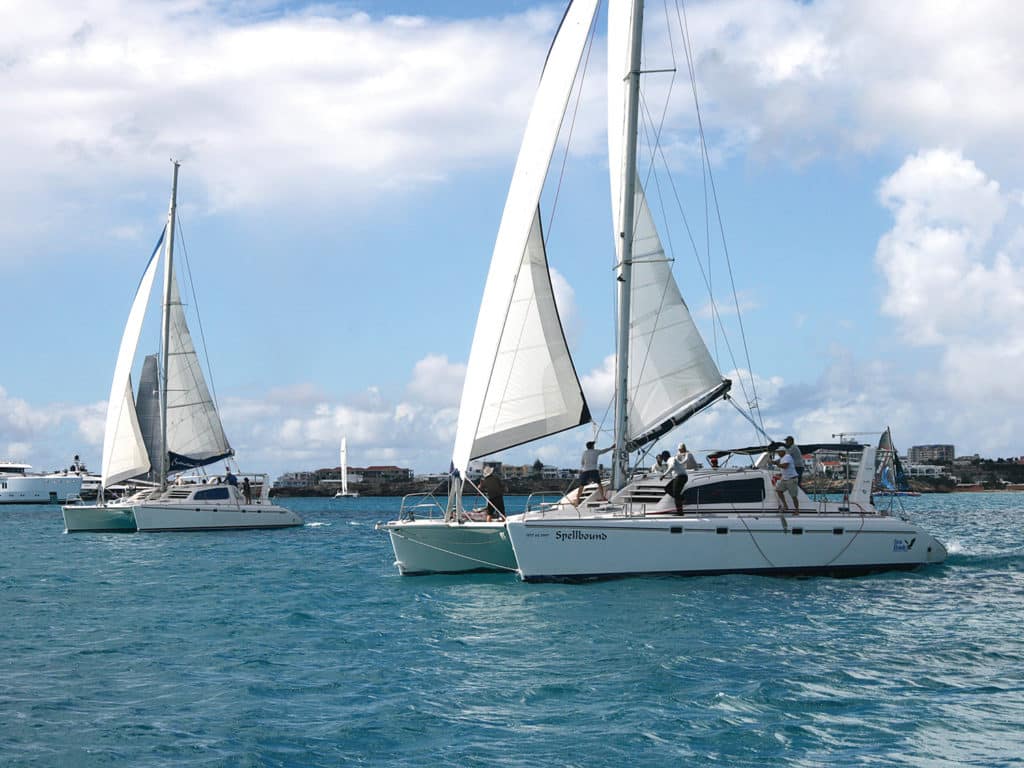
There, in 1969, Tryst was assembled and began life as a day-charter boat, taking tourists out for short sails and snorkeling trips. A decade later, the Turner brothers of St. Maarten acquired her and sailed her to the island where she began offering similar outings from the sibling’s beach bar. Some five years later, the Stoutenbeek family arrived in St. Maarten—including the impressionable young son, Appie—and acquired another Newick tri called TP II. By now, in the mid-1980s, there was a quartet of Newick tris racing against each other in the neighboring islands. Appie called the group “the Newick fanatics.”
Pat Turner was the boat’s loving caretaker for over three decades, nursing and repairing her after many a tropical storm. But when Hurricane Gonzalo ripped through the islands in 2014, and Tryst suffered major damage, it was time to move on. That’s when his friend Arthur Banting took over, and along with his pal, Appie, they made Tryst whole again.
A year later, the boat was back on the water but not yet racing, which is when Appie said to Arthur, “Dude, we need to get her out on the circuit again.”
Soon after, Hurricane Irma arrived.
As the manager of the Lagoon Marina, and knowing Tryst suffered major damage in Gonzalo because her mast was up, Appie pulled the spar and towed the boat into a shallow, protected cove. He placed hundreds of gallons of water in tanks to sink the waterline and reduce windage on the hulls, crossed his fingers and left Tryst to her own devices.
When he returned after the storm, he couldn’t believe his eyes: Tryst was upside down. A witness vacationing at a nearby resort saw what happened. Apparently, Tryst was doing fine until a localized tornado rolled through the anchorage. Appie said, “The guest came down and said, ‘Oh my god, is that your boat?’ He said Tryst went right up in the air, nose down, stern up, still attached to her mooring, doing twists in the tornado. When we found her capsized, there must’ve been 20 turns on the mooring lines!”
Tryst was riding out hurricane Irma just fine until a localized tornado rolled through the cove where she was anchored. a witness saw the tri launched straight into the sky, nose down, stern up, doing twists in the tornado.
Tryst was righted, then went back into the shed and eventually reemerged once again strong and whole…just in time for the Caribbean Multihull Challenge.
“This boat is something special,” said Appie. “For a multihull to survive all these hurricanes, there’s got to be something special with this girl. She doesn’t want to go.” Nope, Tryst wasn’t going anywhere, not just yet. And yes, 50 years along, she was ready for her close up.
Vision Realized
With the exception of an early, passing squall on day two of the three-day event, conditions were ideal, with steady northeast trades in the midteens, occasionally gusting higher. Multihull weather.
The undisputed star of the show was Fujin. Sailing with an all-star crew that included two-time Olympic sailing medalist Jonathan McKee, the 53-footer easily won Class A, topping off a stellar performance with a 2-hour, 25-minute lap of St. Maarten in the round-the-island race on the final day of competition. For her considerable efforts, Fujin was recognized for the regatta’s Most Outstanding Performance and owner Slyngstad received a sweet dive watch from Oris Watches, the event’s official timekeeper.
The Class B winner was Arawak, sailed by a crew of ringers from St. Maarten’s Island Water World. The Class C victor was the Leopard cat Spellbound (renamed Kidz at Sea for the event), sailed by Garth Steyn and Ian Martin, who narrowly edged out their old friend and rival Petro Jonkers on his Leopard. And Tryst, appropriately, also brought home some hardware, earning the regatta’s Style & Grace prize.
“It was the best multihull fleet I’ve ever seen in the Caribbean,” race director Robbie Ferron said. “Our vision of a multihull regatta out of St. Maarten has been solidified.”
Now, having proven the point, the Caribbean Multihull Regatta has announced that the second running of the event will take place beginning on Valentine’s Day in 2020. The event is timed perfectly to be a warm up regatta for the Caribbean 600; in 2019, Fujin used that formula by prepping in St. Maarten for the longer ocean race, where the boat finished second in the multihull class. Either way, if you sail a boat with more than one hull, you might seriously consider getting down there. It seems like a celebration whose time has come.
Herb McCormick is CW_’s executive editor_.








